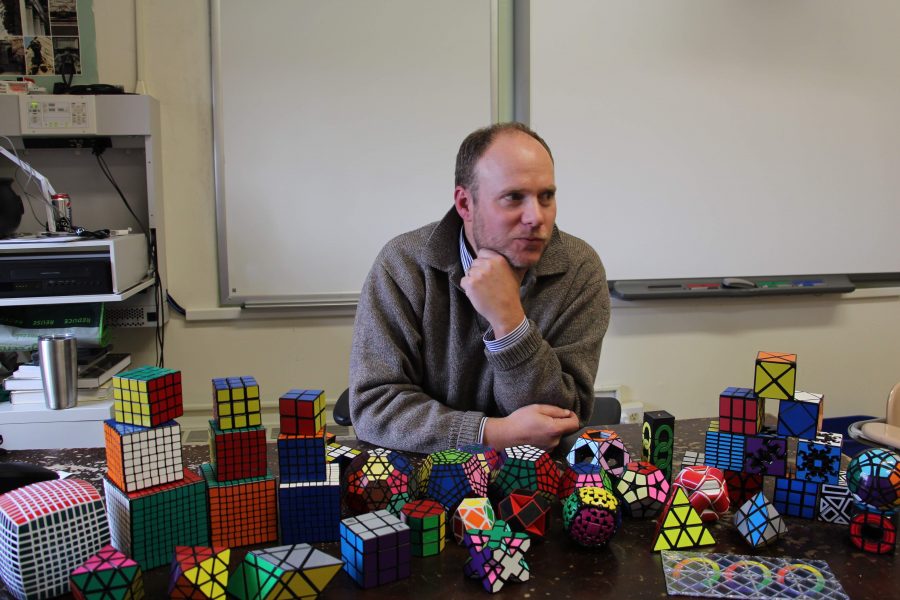Mr. Gruenberg’s passion for puzzles is mind-boggling
Credit: Bridget Barsanti
Mr. Gruenberg surrounds himself with his Rubik’s Cubes while pondering his next move.
February 10, 2017
From the 3x3x3 to the 13x13x13, mathematics and psychology teacher Jon Gruenberg applies his knowledge of geometric patterns with his mental determination to solving Rubik’s Cubes.
Mr. Gruenberg’s passion for math stems from the satisfaction of simplifying a problem down to an elegant solution. “I guess that’s true in both mathematics and life,” he said. Additionally, he appreciates patterns that emerge through exploration of mathematics.
Mr. Gruenberg enjoys studying psychology because he believes it is important to understand what motivates people and why they act and behave in the manner they do. “I find my work in psychology has allowed me to be more patient and understanding with others and has revealed to me the many ways in which I can improve as an individual,” Mr. Gruenberg said, “I can’t think of an instance where it wouldn’t be beneficial to have a greater understanding of yourself and those around you.”
His passion for teaching, however, did not come until college. “In high school I did not have a plan of what I was doing later that week, much less a lifelong plan,” he said. However, Mr. Gruenberg recalls sitting in class as a student, thinking about how he would or would not explain things if he were to teach the lesson. Later on in college, he sought opportunities to work in classrooms and found himself comfortable in those settings.
It was after college that Mr. Gruenberg started solving Rubik’s Cubes. As a kid, he never got very far. Rather than simply peeling off the stickers, as many of his friends did, he learned how to break the cube apart and piece it back together, which he considers “a far more refined way of cheating.” Years later, in his twenties, a friend introduced him to the Rubik’s Cube again and introduced Mr. Gruenberg to some algorithms to solve it. For several years, Mr. Gruenberg practiced these algorithms until they were memorized.
At the last school he taught at, the Hewitt School, he found a cube, solved it, and left it on his desk. At the end of most days, he would find it jumbled, but always solved it before he left school. As a gift, one student gave him a 6x6x6 cube, which he did not even know existed. From there, his interest has grown to over 20 different cubes.
When asked what helps in solving Rubik’s Cubes – his knowledge of mathematics or psychology – he responded by saying, “Both. Neither.” He then explained how it requires determination. His restless mind reminds him that once he starts something, it cannot be left unfinished or unsolved. This determination comes from his knowledge of psychology. On the other hand, mathematically, Rubik’s Cubes require some visual-spatial geometry needed to map algorithms and patterns from one cube to another. He does not solve cubes by studying them for a few seconds and knowing how to solve them, but uses more of what he considers a “brute force method.”
He currently has three cubes he has yet to solve. One fell apart when trying to turn it, and took him hours to put it back together. He also has a Tuttminx in the shape of a truncated icosahedron, which consists of 32 sides. He has not even thought about mixing it up just yet. The third he has yet to solve is a 3x4x5 cuboid.
Mr. Gruenberg’s collection extends from a 2x2x2 all the way up to a 13x13x13. “The 4x4x4 up through the 13x13x13 all solve pretty much the same way and are not that tough. Cubes get more complex as they start turning on different axes.”
To Mr. Gruenberg, finding solutions to complex problems and creating order from chaos offers a sense of accomplishment. “There is something captivating about a puzzle box. The duality of the simplicity and complexity of a Rubik’s Cube is quite impressive,” he commented.

